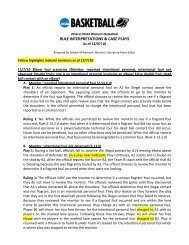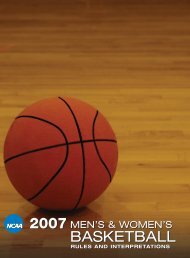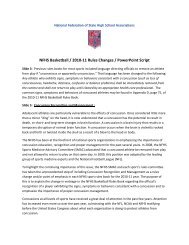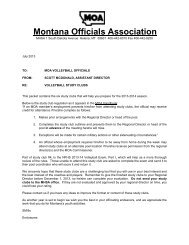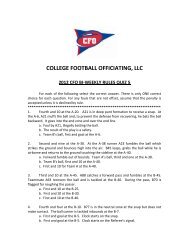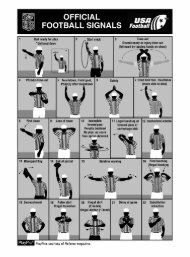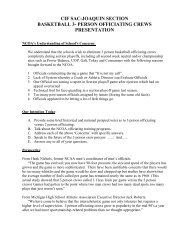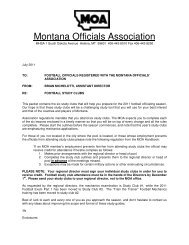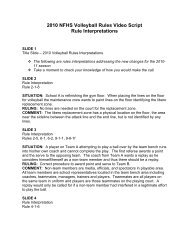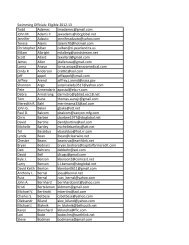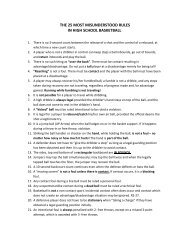MONTANA OFFICIALS ASSOCIATION - MOA - ArbiterSports
MONTANA OFFICIALS ASSOCIATION - MOA - ArbiterSports
MONTANA OFFICIALS ASSOCIATION - MOA - ArbiterSports
You also want an ePaper? Increase the reach of your titles
YUMPU automatically turns print PDFs into web optimized ePapers that Google loves.
SITUATION: A4 is driving down the lane on a try for a goal. A4 leaves the floor to release the ball and<br />
crashes into B4 before returning to the floor. B4 was in the proper guarding position before A4 went<br />
airborne. B4 put his/her arms in front of his/her chest in a recoil position to absorb the contact and turned<br />
his/her body slightly to avoid taking the contact straight in the torso. RULING: Player-control foul on A4.<br />
COMMENT: Once a defensive player establishes proper position, he/she may turn to avoid straight on<br />
contact in an attempt to lessen the blow from the collision.<br />
SITUATION: A5 goes airborne to attempt a field goal try. He/she releases the ball and then crashes into<br />
B5 before returning to the floor. B5 moved into the landing area before A5 went airborne. The try is<br />
successful. RULING: No basket, player-control foul on A5. COMMENT: Good anticipation by B5. He/she<br />
moved into the path of A5 and established a proper defensive position before A5 went airborne. Even<br />
though the ball was released before the contact ensued, the score cannot count and it is a player control<br />
foul.<br />
SITUATION: A2 sets a screen for A1 on the side of B1. B1 pushes A2 with a forearm in an effort to stay<br />
with A1. RULING: Foul on B1. COMMENT: A2 was in the visual field of B1. B1 should have avoided<br />
contact with A2.<br />
SITUATION: A3 sets a screen behind B2. B2 takes 1 and ½ normal steps and collides with A3. A3 is<br />
knocked backward a short distance with the initial contact but after the initial contact B2 pushes right<br />
through A3 to continue guarding his opponent. RULING: Foul on B2. COMMENT: If B2 would have<br />
moved to the right or left of A3 after the initial contact, the play would have been legal and no foul would<br />
have occurred as long as the initial contact was incidental since the screen was not in the visual view of<br />
B2.<br />
SITUATION: A4 sets a screen for A3 at the side of B3. B3 sees the screen and tries to move around A4.<br />
A4 throws his/her hip to the left as B3 is moving around him/her and contacts B3. RULING: Team-control<br />
foul on A4. COMMENT: The screener must be stationary and his/her body must remain in his/her vertical<br />
plane. Moving the hip or extending the arms or elbows beyond the vertical plane is a foul if there is<br />
contact.<br />
SITUATION: A5 is dribbling the ball from his/her backcourt and is being closely guarded by B5. A4 moves<br />
in the path of B5 to set a screen more than two steps behind the visual field of B5. A4 is stationary and<br />
has his/her arms on his/her chest with the elbows protruding beyond his/her vertical plane. B5 collides<br />
hard with A4’s elbow and falls to the floor. RULING: Team-control foul on A4. COMMENT: Arms and<br />
elbows must be within the vertical plane of the screener and must be used in a fashion to absorb the<br />
collision only. They cannot be used to inflict pain on the player being screened by extending them<br />
beyond the vertical plane or thrusting them forward on the player being screened.<br />
SITUATION: A1 rebounds off the opponent’s basket and comes down with the ball swinging his arms and<br />
elbows violently with opponents near him/her. He/she contacts one opponent across the chest very hard.<br />
RULING: Intentional foul on A1. COMMENT: Excessive swinging of arms and elbows is a violation if no<br />
contact is made. However, if contact is made, it has to be at least an intentional foul. It may be a flagrant<br />
foul, but it has to be at least an intentional foul.<br />
SITUATION: PLAYING WITH 5 PLAYERS. Team A has very few players to field a Varsity and JV<br />
team. The Varsity players are on a strict quarter limit. Team A puts at least four varsity players in the JV<br />
book, and have each one play one quarter; that way they still have all four quarters for the varsity game.<br />
For the last quarter of the game, the varsity players that have played one quarter go to the locker room to<br />
get ready for the varsity game. Team A has no players sitting on the bench during the last quarter of the<br />
JV game. With 2:13 left in the fourth quarter of the game, Team A was winning 33–27 when a Team A<br />
player fouled out. Team A had no one on the bench and told the refs they would finish with four. The<br />
officials would not let Team A finish with 4 players and said since players’ names were still in the book,<br />
Team A had to use them, which meant pulling them out of the locker room. Team A refused to put them<br />
in the game and the varsity coach came out and explained those players need those quarters so they can<br />
be eligible for the whole varsity game. The officials said if Team A refuses, they would be assessed<br />
a technical foul; if they refuse again, they’ll assess another T, and the coach is ejected. Then after




